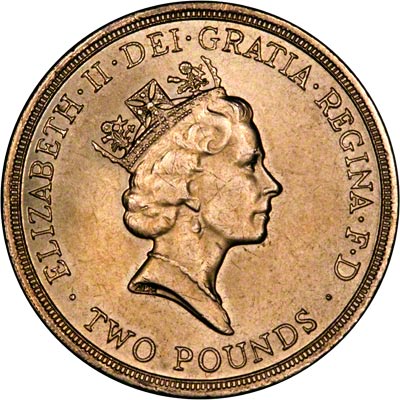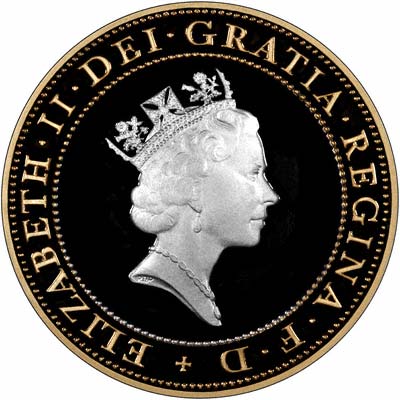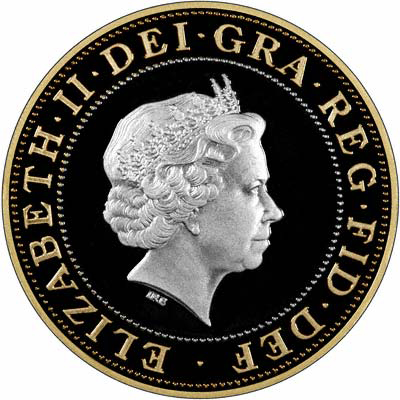| The Very Highest Quality Advice... |
| Two Pound Coins "With Necklet" - Rumour |
|
 |
 |
 |
An Urban Myth
During 1999, we became aware of a persistent rumour that a two pound coin with the queen wearing a necklet was worth £15. There is no truth in this rumour. It is the sort of story which appears to start for no particular reason, and then self-perpetuates in a form of "Chinese whispers", so that it becomes part of an urban folklore of misinformation.
1997 Bi-metallic Issue
The rumour relates to the 1997 new bi-metallic two pounds coin.
The nearest we can come to solving the "mystery of the queen's necklet" is that a listener phoned a Red Rose Radio / Rock FM phone-in programme, and said that he had heard, from where or whom we do not know, that a two pound coin with the queen wearing a necklet was worth £15. That afternoon we received about four telephone calls all asking was it true, etc.. We were able to quickly ascertain that there was no known rarity or error.
1986 to 1996 Nickel-brass Issues
All two pound coins from 1986 to 1997 bear the queen's third portrait in which she is shown wearing what appears to be a pearl necklet, from 1998 the obverse (head side) design changed to a more mature fourth portrait, in which the portrait of Her Majesty is shown truncated at the neck rather than the shoulder. She therefore appears without a necklet.
The Rumour Won't Die!
We had originally thought that within a few weeks of the radio programme, this particular rumour would die a natural death, but unfortunately it appears to have started to replicate itself, and we still receive numerous telephone calls and e-mails about it. As the weeks pass by, the "value" jumps around, and although £15 is the commonest figure we hear, sometimes it changes to £5, £17, and other figures.
Some People Know Better
A few weeks after the programme, we had a visitor who asked us about the story, and when we told him the facts, he informed us that we were wrong (so why he asked we don't know!), and that he knew somebody who had sold one for £15 plus the £2 face value. We told him that we could find hundreds of them, and that if he could point us to the buyer we would split the profits with him. Apparently it was someone he was talking to in a pub who had sold it to a dealer in Birkenhead. So far he has not been back to claim his share of our potential profits!
If anybody out there knows who made the phone call to the radio station, please let us know, or better still shoot him, and then let us know!
It Can't Be True - It Was In "The Sun"
Since we wrote the above, we believe that the rumour has also appeared in "The Sun" newspaper, which is probably enough to warn most people that the rumour is totally unfounded, and on at least one TV programme.
Obviously the rumour-monger is really having great fun!
Mintage Figures
It is true to say that there were some initial problems with this, the first of the new bi-metallic two pound coins to be produced.
Although it was the UK's first bimetallic coin, they have been in use in other countries for quite a few years, and the Royal Mint have been responsible for producing many bi-metallic coins for other countries.
Teething Troubles With Vending Machines
A small number of vending machine manufacturers appear to have had problems calibrating their older equipment to the "electronic signature" of the new coin, and because of this, the new coin was not officially launched until June 1998, instead of November 1997 as originally planned.
Never Recalled
Because of this, some people have "guessed" or assumed that the 1997 dated coins must have been recalled, or only issued in small quantities. This is not the case.
Quantities Issued
The Royal Mint's issue figures for 1997 show 13,734,625 nickel-brass two pound coins were issued in 1997, followed by 67,268,125 in 1998, excluding special editions for sale to collectors. It is possible that some of the coins produced and issued in 1998 were actually dated 1997, because the Royal Mint, being an efficient factory, does not discard its stock of perfectly usable dies on December 31st each year, but continues using its stock for several months into the new year. During a visit to the Royal Mint on Thursday 9th March 2000, I saw 1999 dated £2 coins still being produced. From this and a small random sampling of £2 coins in circulation, I think it is safe to assume that about 14 million 1997's were issued.
For more information, see our mintage figures page.
Enough To Go Around?
Obviously if every one of the UK's approximate 60 million population decided that all wanted a 1997 £2 coin, there would not be enough to go around, and in that case I am sure they would start selling for a few pounds over their face value, but it is more likely that any collectors would prefer the superior finish of the specimen version which we have on sale at £6 each (see below).
Two Much Rarer Coins
If anybody thinks that 14 million is a low mintage figure, they would be well advised to look at the year 2000 gold sovereigns and half sovereigns. Only 250,000 of each will be produced, making them over 50 times rarer. Because they are an historic gold coin with world-wide recognition, they will be in great demand. Our selling price for sovereigns, currently £65 each, represents about £20 or less than 50% premium over their intrinsic metal value (about £45).
See our new Gold Sovereigns web site for more details.
Previous Two Pound Coins
From 1986 to 1996, £2 coins were produced in nickel-brass, which looks a goldish colour. "Only" 25,631,047 were produced in six different designs in five different years.
This makes a total of 39,365,672 "necklet" two pound coins - hardly rare!
Specimens For Sale
We have some specially produced "Specimen" versions of the coin in question, in a beautifully produced and informative folder at £6 each or - Special Offer - 3 for £15.
More Information
Visit our £2's For Sale page.
Worth Keeping Coins From Change?
If you want to find the value of a coin you own, please take a look at our page I've Found An Old Coin, What's It Worth?
Or you could check out our £2 Coin Values page.
Please, if you are going to ask us whether the £2 coin you own is worth more than £2, please, please, please read our other pages about them first, and even then the answer is almost certainly no. About 1,000 people every week read one or more of our pages about £2 coins. Hopefully most manage to find what they wanted. A tiny percentage, but still about 20 per week ask us whether a £2 they have found in change / in a drawer / been given is worth more than £2. The answer to 99% of these questions is already on our site. We do not have the time or patience to answer such questions individually.
Buying Coins
We also buy coins, please see our We Buy Coins page.
If you have a coin which you want to sell, and you know how much you want for it, you can use the form below to contact us:-
| ...at the Lowest Possible Price |
|
32 - 36 Harrowside, Blackpool, Lancashire, FY4 1RJ, England. Telephone (44) - (0) 1253 - 343081 ; Fax 408058; E-mail: The URL for our main page is: https://24carat.co.uk | Chard(1964) Ltd |